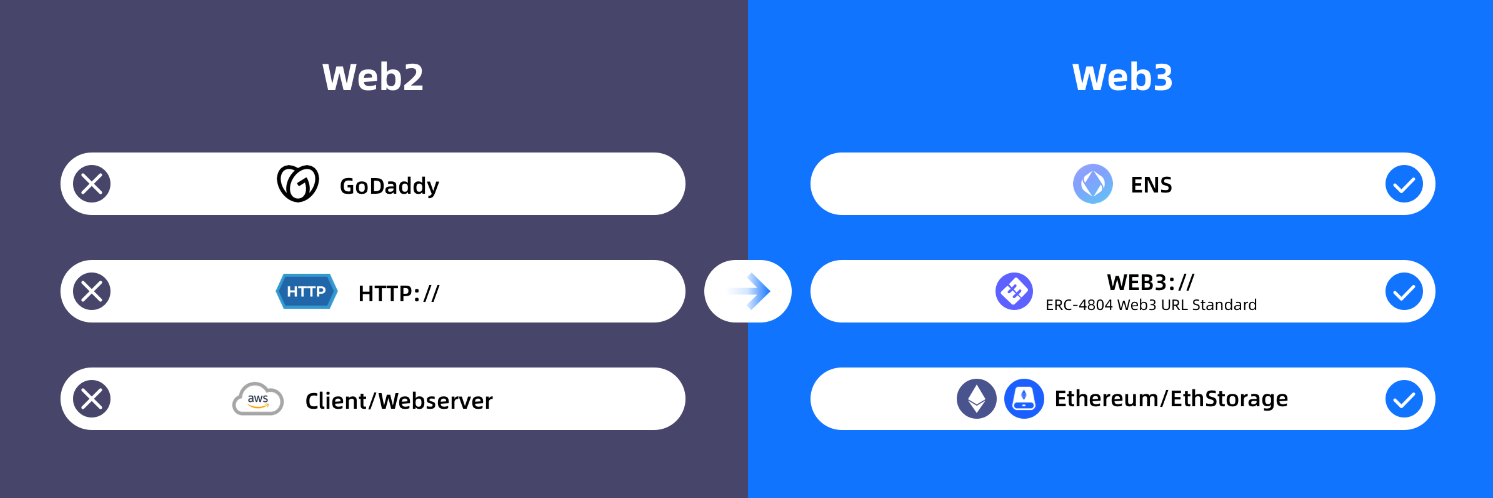Web3 URLs – enabled with the launch of ERC-4804 – have made it onto Ethereum, allowing internet users to access Ethereum apps and NFTs without worrying about centralized censorship.
The new Ethereum standard, titled “Web3 URL to EVM Call Message Translation,” was first proposed on Feb. 14, 2022, and was co-authored by ETHStorage founder Qi Zhou, Ethereum researcher Sam Wilson and Chao Pi.
It described the proposal as an “HTTP-style” URL to directly access on-chain Web3 content, such as decentralized apps (DApps) front-ends and NFTs. More than a year later, ERC-4804 was approved and finalized on the mainnet on March 1.
1/n, I am delighted to announce that the first web access protocol for ETH ERC4804: Web3 URL is approved by EIP editors and finalized!
web3:// (https://t.co/uXpTGdXirF) is decentralized http://. It allow users to directly browse the rich web content on EVM, pages/images/songs!
– Qi Zhou (@qc_qizhou) March 1, 2023
Anthurine Xiang, a spokesperson for layer-2 storage protocol ETHStorage, explained that in many cases, the ecosystem is still reliant on centralized web servers to provide access to “decentralized” apps.
“Right now, all the DApps like Uniswap […] claim to be decentralized apps,” Xiang explained, adding: “But how [do] we get on the webpage? You have to go through the DNS. You have to go through GoDaddy. […] All those are centralized servers.”
 Graphic explaining how the new model compares to Web2. Source: w3eth.io
Graphic explaining how the new model compares to Web2. Source: w3eth.io
Today, most users access the internet via “Hypertext Transfer Protocol,” widely known as HTTP.
When an internet user clicks a link or types in a website address, the computer uses HTTP to ask another computer to retrieve the information, such as a website or pictures.
Under ERC-4804, internet users have the option to type in web3:// (as opposed to http://) in their browsers to directly bring up DApps such as Uniswap or on-chain NFTs. This is because the standard allows users to directly run a query to an Ethereum Virtual Machine (EVM).
 Flow chart explaining how Web3 URL standard works with Uniswap. Source: w3eth.io
Flow chart explaining how Web3 URL standard works with Uniswap. Source: w3eth.io
Entire websites can also theoretically be accessed by these means as long as their content is stored on the Ethereum blockchain or a compatible layer-2 protocol. However, the costs of doing this are still very prohibitive, according to ETHStorage founder Qi Zhou.
“The critical issue here is that the storage cost on Ethereum is super, super expensive on mainnet,” Zhou said in a recent presentation at ETH Denver.
“For example, 1 Gigabyte of on-chain data will cost roughly $10 million. […] That is unacceptable for a lot of Web2 applications and even a lot of NFTs,” Zhou added, noting that layer-2 storage solutions could help mitigate some of the costs.
Xiang suggested that given the costs, the new URL standard makes sense only for specific applications.
“Not everything needs to go decentralized. If you are running a pretty good Web2 business and you don’t have to worry too much about centralized censorship. […] You can just go for that.”
On the other hand, the new standard would be useful for DApps or websites that are at risk of censorship, with Tornado Cash as an example.
“For example, for Tornado Cash, a lot of people can’t get to them through their website because there’s censorship,” Xiang explained.
“If you’re a DApp and you’ve already been decentralized, why are you still using a centralized website for people to get access to you?”
 Example of websites that are able to be accessed via web3:// URL Source: w3eth.io
Example of websites that are able to be accessed via web3:// URL Source: w3eth.io
Asked whether the new standard could be leveraged by bad actors to partake in illicit activity, Xiang said:
“This is really hard to say just like how Bitcoin was founded. I think Bitcoin was not born for evil, but still, in the beginning, people [were] doing shady things like the Silk Road, they had been using Bitcoin.”
Instead, Xiang believes like Bitcoin, they’re just giving people a decentralized option they may not have otherwise.
The new Ethereum standard is the first of its kind for the blockchain, noted Xiang, though it’s not the first solution to decentralized web hosting.
Related: How to host a decentralized website
IPFS, or the InterPlanetary File System is an example of a network that was created to do what centralized cloud servers currently provide, only via decentralized means. However, Xiang noted that an IPFS URL can only link to static content, which can’t be amended or changed.
I *use* IPFS to store my blog. It has serious UX issues (took ~1h for my last update to propagate). Sticking the blog on-chain would have been way easier.
For blogs, that’s unfortunately too expensive, but for short text records the logic applies.
– vitalik.eth (@VitalikButerin) May 27, 2022
ERC-4804 however, will allow for “dynamic data,” such as allowing people to leave likes and comments and interact with content on a website, explained Xiang. Being Ethereum native, the standard is also expected to be able to interact with other blockchains much easier, Xiang added.


